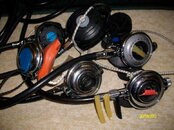Got my Duro Poppet toady and installed it in my r109 and it seams to work great. Does anyone who where there is a good thread that talks about the procedure of adjusting the cracking pressure?
What are you guys using to turn the orifice that will not damage it?
It's not worthy of a thread, it's so simple. Start with the reg assembled, but no diaphragm or case cover in place.
1. Set the adjustment knob all the way out.
2. Set the orifice (use a thin blade screwdriver and depress the lever while turning) so that it just barely makes the lever move; this means when you release the lever after turning the orifice in, it doesn't quite return to full height.
3. Attach a hose and pressurize. Freeflow? Remove the hose, screw in the orifice 1/8 turn or so, repeat until there's no flow. If there's no freeflow, screw out the orifice 1/8 turn until it starts to flow, then back in 1/8 turn. This is where using an inline adjusting tool adds some convenience, but there's no problem just removing and attaching the hose each time, you just need it finger tight. Besides, what's your rush?
4. Put the diaphragm in and case cover on. If that makes it flow, adjust the orifice in another 1/8 turn or less.
If you want to check the cracking effort in water, you can just use a sink or big bowl (don't use the toilet, that's a little disgusting....) and slowly submerge the reg mouthpiece up. You'll hear it flow and you can easily get a reasonably close indication of the cracking effort. If you really need a number, buy a magnehelic and use it.





